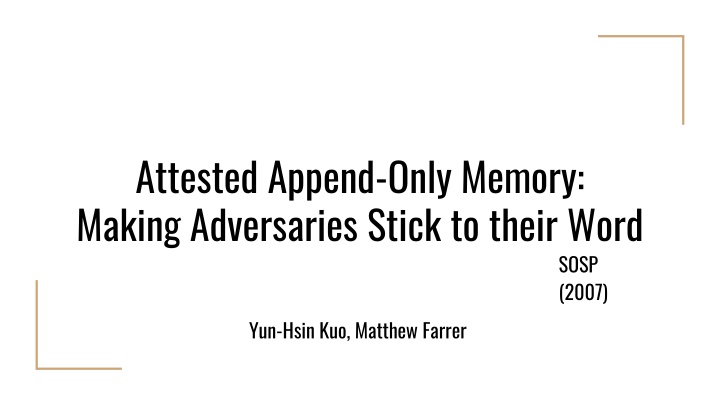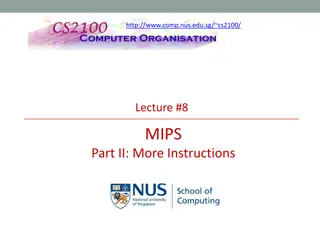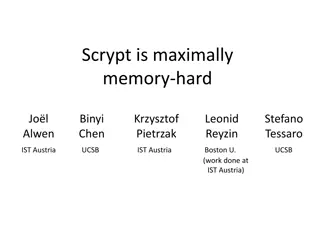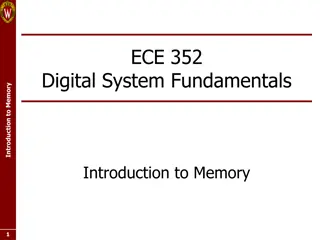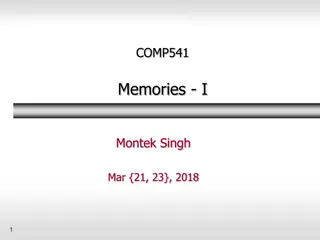Secure Append-Only Memory for Byzantine Fault Tolerance
Explore the concept of Attested Append-Only Memory (A2M) in distributed systems, which ensures adversaries adhere to their commitments. Learn about safety and liveness goals, Practical Byzantine Fault Tolerance (PBFT), equivocation issues, and the A2M log and interface for secure data management. Discover solutions to the Byzantine generals problem to enhance system reliability.
Download Presentation

Please find below an Image/Link to download the presentation.
The content on the website is provided AS IS for your information and personal use only. It may not be sold, licensed, or shared on other websites without obtaining consent from the author.If you encounter any issues during the download, it is possible that the publisher has removed the file from their server.
You are allowed to download the files provided on this website for personal or commercial use, subject to the condition that they are used lawfully. All files are the property of their respective owners.
The content on the website is provided AS IS for your information and personal use only. It may not be sold, licensed, or shared on other websites without obtaining consent from the author.
E N D
Presentation Transcript
Attested Append-Only Memory: Making Adversaries Stick to their Word SOSP (2007) Yun-Hsin Kuo, Matthew Farrer
Background Goals in Distributed Systems are Safety and Liveness Safety: System reaches agreement on serial ordering of transactions (linearizability) Liveness: Client eventually receives response to request.
Background Practical Byzantine Fault Tolerance (PBFT) protocol tolerates Byzantine faults, so long as faulty replicas are less than 1 / 3 of total. One type of Byzantine fault is equivocation. A2M paper investigates whether a system based on trusted components can tolerate more Byzantine faults. Goal is to make equivocation extinct or evident.
Equivocation Byzantine generals problem not solvable for 3 parties when 1 is faulty. Fred! Joe! What s your name? What s your name?
Attested Append-Only Memory (A2M) Log A2M q Inside a trusted component 1, x1, d1 Authentication Isolated from the rest of system 2, x2, d2 Provide same response to same query Secure Hashing ... n, xn, dn
A2M Interface A2M Append(q, x) q Append value x to log q Advance(q, n, x) Similar to Append() 1, x1, d1 Authentication 2, x2, d2 Allows log q to skip ahead to n ... Secure Hashing 9, x9, d9 10, x10, d10 Append(q, x = h(msg))
A2M Interface A2M Lookup(q,n) Returns Lookup Attestation, <LOOKUP q, n, x> Tells us what value is present in log q at position n End(q) Returns End Attestation, <END q, x> Last entry of log q q 1, x1, d1 Authentication 2, x2, d2 Secure Hashing ... <LOOKUP q, n, xn> n, xn, dn Lookup(q, n)
A2M Log Why is this useful? We can demand that a replica includes A2M attestation with certain messages. We can compare attestation to message to detect lying.
PBFT Review Three-phase consensus protocol Pre-prepare, Prepare, and Commit In a network with N replicas Replicas consist of 1 primary and N - 1 backups. PBFT can tolerate at most faults F = (floor function) (N - 1) / 3 faulty replicas. I.e., Faults must be less than N / 3
PBFT Review Preprepare Primary multicasts Pre-prepare message to replicas Primary appends same message to its log. (Note - this is not the same as an A2M log) Prepare Backups multicast Prepare message that matches Pre-prepare message Appends same to its message log. A replica is Prepared iff it receives a Pre-prepare message and 2F or more matching Prepare messages
PBFT Review Commit If a replica is Prepared, it multicasts a Commit message and appends the same to its log A replica enters Committed state iff it receives 2F + 1 or more commit messages. Reply Upon entering Committed state, replica may execute client request and send Reply message to Client Client waits for F+1 replies with the same result
PBFT Agreement Execution Pre- prepare Request Prepare Commit Reply Client Primary Replica 1 Replica 2 Replica 3
A2M-PBFT-E Protect the execution portion of PBFT Equivocation to clients will be detected One history A2M log serves as the agreed request sequence Appends Reply messages Pre- prepare Request Prepare Commit Reply Client Primary Replica 1 Replica 2 Replica 3 Attested by A2M
A2M-PBFT-E Execution A2M3 q Commit Reply 2F+1 replies Authenti cation Client Primary ... Secure Hashing <msg, <LOOKUP>> Replica 1 n, h(req), dn Replica 2 <LOOKUP q,n, h(req)> Replica 3 Append(q, h(req)) Attested by A2M
Prevent Equivocation to client For every sequence number, all clients accept the same request Proved by contradiction : clients accept different requests F+1 non-faulty replicas But attestations are the same For the same sequence number, h(req1) = h(req2) +1 accepts req1 +1 F 2F Due to collision- resistance, Client 1 2F faults req1 = req2 accepts req2 +1 2F 2F Client 2 req1 != req2
Linearizability and Liveness For every sequence number, all clients accept the same request Linearizability When no more than of total replicas are faulty Linearizability and Liveness are both guaranteed Same as PBFT When more than , but less than of total replicas are faulty Only Linearizability is guaranteed Size of 2F+1 reply messages Equivocation to servers can happen Divergence in history log
A2M-PBFT-EA Protects execution and agreement. Equivocation to clients or replicas will be detected Agreement Execution Pre- prepare Prepare Commit Reply Request Client Primary Replica 1 Replica 2 Attested by A2M
A2M-PBFT-EA Appends A2M attestation to all protocol messages One committed history log A2M-PBFT-E Additional message logs to record individual message e.g., Commit messages have their own message log Use Advance
A2M-PBFT-EA F+1 messages in all phases Agreement A2M2 Pre- prepare qc Request Prepare Commit Reply Authenti cation Client ... Primary Secure Hashing Replica 1 n, h(req),dn <msg, <LOOKUP>> Replica 2 Commit Msg Log <LOOKUP, qc, n, h(com)> Advance(qc, n, h(com)) Attested by A2M
Linearizability and Liveness For every sequence number, all non-faulty replicas commit same request Size of F+1 messages i.e., single committed request sequence F+1 non-faulty replicas can tolerate F faults A primary and two replicas When no more than of total replicas are faulty Linearizability and Liveness are both guaranteed
Comparison PBFT S & L A2M-PBFT-E Liveness Safety A2M-PBFT-EA Safety & Liveness
A2M-Storage A single untrusted server shared by multiple clients Improved from SUNDR and is simpler SUNDR only guarantees fork consistency Linearizability is guaranteed
SUNDR Secure Untrusted Data Repository An untrusted single-server shared by multiple clients Current state n Pending operations SUNDR server req State n + Client 1 Client 2
SUNDR Secure Untrusted Data Repository An untrusted single-server shared by multiple clients Current state n Pending operations SUNDR server State n+1 State n + State n + State n+1 Fork consistency Client 1 Client 2
A2M-Storage Timestamp_n Timestamp_n+1 Current state n Current state n+1 The server maintain two logs qs: state version log qh: request history log Timestamp = < n, <END qs, n>, <END qh, n>> Every client knows its latest timestamp Linearizability Client only accepts reply with 2 A2M attestations req, state n+1, timestamp_n A2M-S server 2 atts, state n+1 digest Client 1 Timestamp_n Timestamp_n-2
Evaluation Software A2M implementation, i.e., library A2M-PBFT-E and A2M-PBFT-EA Authentication: MACs or signatures Message authentication codes are faster than digital signatures Microbenchmarks Involves executing a very small (null) instruction Macrobenchmarks Software package compilation instructions executed by replicas. Takes longer
Microbenchmarks Client sends 100,000 null operations to client Findings: MAC authentication results in less processing time
Macrobenchmarks Software package compilation in NFS Single server
Varying Delay Time Impose various delays on each A2M request Batching: bundling Append/Advance with Lookup
Is A2M the right trusted abstraction? Key-value pairs may be alternatives? A2M can cover both replicated and single-server system Trivial solution: Larger trusted abstraction e.g. push PBFT into the trusted computing base Complex implementation
Conclusion A2M is a trusted log Easy to implement and only requires small memory Renders equivocation extinct or evident Improve the fault tolerance bounds in the distributed system A2M-PBFT-E and A2M-PBFT-EA Linearizability achieved in an untrusted single-server system A2M-Storage Minor computational overhead
